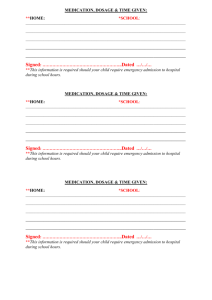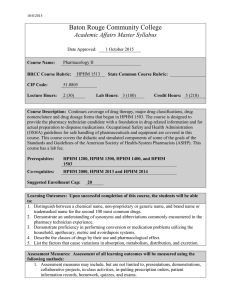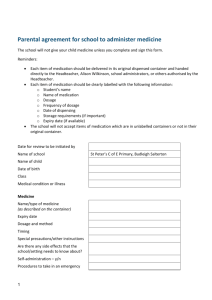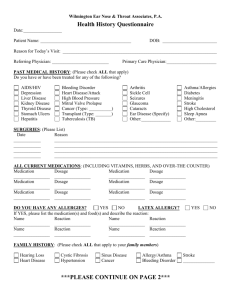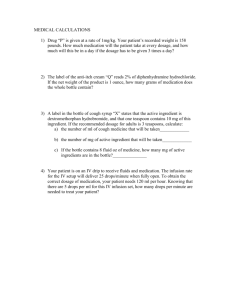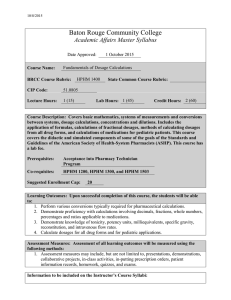Course Form
advertisement
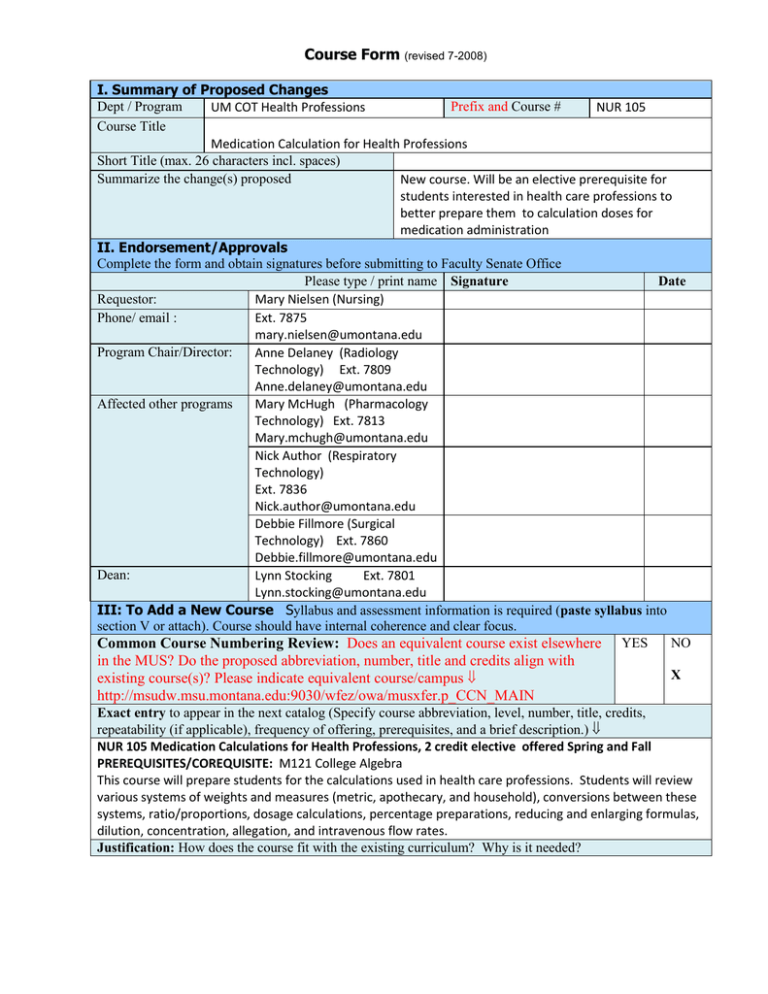
Course Form (revised 7-2008) I. Summary of Proposed Changes Dept / Program Prefix and Course # UM COT Health Professions NUR 105 Course Title Medication Calculation for Health Professions Short Title (max. 26 characters incl. spaces) Summarize the change(s) proposed New course. Will be an elective prerequisite for students interested in health care professions to better prepare them to calculation doses for medication administration II. Endorsement/Approvals Complete the form and obtain signatures before submitting to Faculty Senate Office Please type / print name Signature Date Requestor: Mary Nielsen (Nursing) Phone/ email : Ext. 7875 mary.nielsen@umontana.edu Program Chair/Director: Anne Delaney (Radiology Technology) Ext. 7809 Anne.delaney@umontana.edu Affected other programs Mary McHugh (Pharmacology Technology) Ext. 7813 Mary.mchugh@umontana.edu Nick Author (Respiratory Technology) Ext. 7836 Nick.author@umontana.edu Debbie Fillmore (Surgical Technology) Ext. 7860 Debbie.fillmore@umontana.edu Dean: Lynn Stocking Ext. 7801 Lynn.stocking@umontana.edu III: To Add a New Course Syllabus and assessment information is required (paste syllabus into section V or attach). Course should have internal coherence and clear focus. NO Common Course Numbering Review: Does an equivalent course exist elsewhere YES in the MUS? Do the proposed abbreviation, number, title and credits align with existing course(s)? Please indicate equivalent course/campus http://msudw.msu.montana.edu:9030/wfez/owa/musxfer.p_CCN_MAIN X Exact entry to appear in the next catalog (Specify course abbreviation, level, number, title, credits, repeatability (if applicable), frequency of offering, prerequisites, and a brief description.) NUR 105 Medication Calculations for Health Professions, 2 credit elective offered Spring and Fall PREREQUISITES/COREQUISITE: M121 College Algebra This course will prepare students for the calculations used in health care professions. Students will review various systems of weights and measures (metric, apothecary, and household), conversions between these systems, ratio/proportions, dosage calculations, percentage preparations, reducing and enlarging formulas, dilution, concentration, allegation, and intravenous flow rates. Justification: How does the course fit with the existing curriculum? Why is it needed? The most advanced therapeutic medication is of no value unless it is administered accurately. Those that administer the medication must be sufficiently schooled and skilled to calculate the dosage of all medications. A great number of patient injuries are caused by incorrect drug calculations. UM COT Health Professions would like to help prevent these types of injuries by better preparing students in the area of correct medication dosage and calculations. Due to the transfer initiative, some Health Professions Programs have had course curriculum changes and credit caps that have decreased the time spent in some areas of health care. Dosage calculation is one of these areas. This elective is an introduction to the important concept of dosage calculation and medication administration for the student interested in health care professions. It will better prepare students for the core material of their chosen health care program. Are there curricular adjustments to accommodate teaching this course? No Complete for UG courses. (UG courses should be assigned a 400 number). Describe graduate increment (Reference guidelines: http://www.umt.edu/facultysenate/Grad/UG.htm) NA Fees may be requested only for courses meeting specific conditions determined by the YES NO Board of Regents. Please indicate whether this course will be considered for a fee. X If YES, what is the proposed amount of the fee? Justification: IV. To Delete or Change an Existing Course – check X all that apply Deletion Title Course Number From: Level U, UG, G Change To: Description Change Change in Credits From: To: Prerequisites 1. Current course information at it appears in catalog (http://www.umt.edu/catalog) From: To: Repeatability Cross Listing (primary program initiates form) Is there a fee associated with the course? 2. Full and exact entry (as proposed) 3. If cross-listed course: secondary program & course number 4. Is this a course with MUS Common Course Numbering? If yes, then will this change eliminate the courses common course status? Please explain below. 5. Graduate increment if level of course is changed to UG. Reference guidelines at: http://www.umt.edu/facultysenate/Grad/UG.htm (syllabus required in section V) Have you reviewed the graduate increment guidelines? Please check (X) space provided. 6. Other programs affected by the change 7. Justification for proposed change V. Syllabus/Assessment Information Required for new courses and course change from U to UG. Paste syllabus in field below or attach and send digital copy with form. Syllabi attached VI Department Summary (Required if several forms are submitted) In a separate document list course number, title, and proposed change for all proposals. VII Copies and Electronic Submission. After approval, submit original, one copy, summary of proposals and electronic file to the Faculty Senate Office, UH 221, camie.foos@mso.umt.edu. THE UNIVERSITY OF MONTANA-MISSOUA COLLEGE OF TECHNOLOGY INTRODUCITON TO DOSAGE AND CALCULATION FOR HEALTH PROFESSIONS COURSE SYLLABUS COURSE NUMBER AND TITLE: Introduction to Dosage and Calculation for Health Professions DATE REVISED: 09/2009 SEMESTER CREDITS: 2 CONTACT HOURS PER SEMESTER: 30 lecture hours PREREQUISITES/COREQUISITE: M121 College Algebra Faculty: TBA E-Mail: Phone: Office: Office Hours: Course Description: This course is intended to provide the student the theory and psychomotor skills to correctly and safely calculate medications to clients in diverse health care settings. It will prepare students for the calculations used in health care professions. Students will review various systems of weights and measures (metric, apothecary, and household), conversions between these systems, ratio/proportions, dosage calculations, percentage preparations, reducing and enlarging formulas, dilution, concentration, allegation, and intravenous flow rates. Relationship to program(s): It is imperative that health care students have solid math skills in order to perform the functions necessary for safe medication dosage preparation and administration. This course will prepare students with the necessary math skills to perform the functions required in calculating and preparing medications for safe administration to patients across the various health care professions. STUDENT PERFORMANCE OUTCOMES: Upon completion of this course, the student will be able to: Calculate and complete basic math skills in roman numerals, fractions, decimals, ratios, and percentages. Convert apothecary, metric or household weights and measures to its equivalent; e.g. apothecary to metric or household. Calculate dosages based on weight of client Examine and interpret weight and measure equivalents to correctly solve oral and parenteral dosage problems. Identify and describe use of a variety of dosage calculation methods and formulas for safe medication administration. Identify the variety of methods of medication administration. This includes oral medications, liquid, tablet, capsule, caplet, topical, injectable, and intravenous. Introduction to safety reduction of medication errors in the pediatric and adult client. Calculate IV drip rates through demonstration using a variety of drip size administration sets. Text: TBA Supplies: A simple calculator
